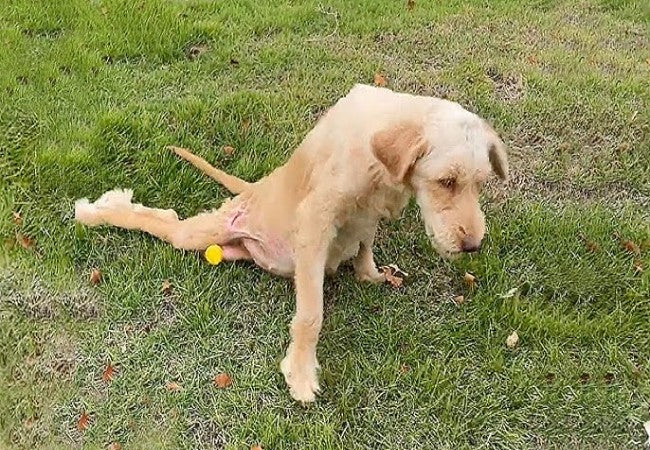Vet’s 2025 Guide to Paralysis in Dogs Types, Causes & Care Strategies🩺

In this article
Vet’s 2025 Guide to Paralysis in Dogs: Types, Causes & Care Strategies🩺
By Dr. Duncan Houston BVSc
💡 Introduction
Seeing your dog unable to walk or move can be heartbreaking. In 2025, we’ve got advanced diagnostics, surgical techniques, and supportive care to address a range of paralysis causes—from intervertebral disc disease (IVDD) to tick paralysis, degenerative myelopathy, and laryngeal paralysis. This in-depth guide will equip you with the knowledge to understand symptoms, navigate diagnostics, explore treatment options, and provide compassionate home care. Ask A Vet is here to support you around the clock. 🐶❤️
1. What Is Paralysis?
Paralysis is the loss of voluntary movement in one or more body regions. It occurs when nerves—whether in the brain, spinal cord or peripheral nerves—can’t communicate with muscles. Weakness and loss of sensation may accompany paralysis.
2. Common Types & Causes of Paralysis
2.1 Intervertebral Disc Disease (IVDD)
Common in small breeds like Dachshunds, IVDD involves disc herniation that compresses the spinal cord, causing pain and sudden paralysis. Diagnosis relies on MRI or CT. Treatment may include conservative rest and steroids for mild cases, or emergency spinal surgery (decompression) if paralysis is severe.
2.2 Tick Paralysis
Caused by neurotoxins from certain tick species. Symptoms start with hind limb weakness and can escalate to full body paralysis, affecting breathing and swallowing. Removing the tick usually reverses symptoms within 24–72 hours. Preventatives and thorough tick checks are key in endemic areas.
2.3 Degenerative Myelopathy (DM)
A genetic, progressive disease, often seen in German Shepherds, Boxers, and Corgis. Begins with hind limb weakness and leads to paraplegia, sometimes affecting front limbs too. No cure exists, but targeted physiotherapy, hydrotherapy, harnesses, mobility carts, and laser therapy can preserve quality of life. Survival ranges from 6 months to >3 years.
2.4 Laryngeal Paralysis & GOLPP
Here, the nerves that open the larynx fail—leading to partial airway obstruction, noisy breathing, exercise intolerance, and sometimes progressing to generalized polyneuropathy (GOLPP). More common in older Labradors, Goldens, Huskies, and St. Bernards. Treatment may include surgical “tie-back” or silicone stents, plus harness use and climate control.
2.5 Other Nerve or Spinal Causes
- Trauma: Fractures, dislocations can injure spinal or nerve roots.
- Nerve root tumors or infection: May cause gradual paralysis.
- Wobbler Syndrome: Cervical spinal compression in Great Danes and Dobermans.
- Facial paralysis: Affects facial nerve only—separate from limb paralysis.
3. Recognizing Symptoms
Classic signs include:
- Sudden or gradual limb weakness or paralysis (one or multiple limbs)
- Dragging feet, ataxia, knuckling paws
- Loss of bladder or bowel control in severe cases
- Respiratory distress, especially with tick paralysis or laryngeal cases
- Swallowing difficulties, weak bark or cough (laryngeal involvement)
- Nerve-related pain, altered reflexes, sensation loss
Tip: Note whether symptoms come on suddenly (e.g., trauma, tick) or incrementally (e.g., DM, IVDD).
4. Diagnostic Steps in 2025 🧪
4.1 Physical and Neurological Exams
Your vet will test reflexes, pain perception, proprioception (body awareness), and palpate the spine and limbs.
4.2 Blood & Tick Screening
Check for tick-borne diseases; look for organ, metabolic, or infectious abnormalities.
4.3 Imaging
- X-rays: To detect fractures, IVDD, Wobbler changes
- MRI/CT: Gold standard for spinal cord, tumors, and disc herniation.
- Myelography: Used when advanced imaging is unavailable
4.4 Genetic & Specialized Tests
DNA test for DM-related SOD1 mutation. Laryngeal function confirmed via videoendoscopy.
5. Treatment & Care Options
5.1 Emergency Management
- Tick removal & supportive care in tick paralysis
- Stabilize spine & surgery in acute IVDD or trauma
- Oxygen therapy, cooling and airway management in laryngeal cases
5.2 Surgery & Medications
- IVDD: Decompression surgery—efficacy depends on timing
- Laryngeal paralysis: Arytenoid lateralization (“tie-back”) or silicone stent
- Pain relief: NSAIDs, steroids, gabapentin
5.3 Supportive & Rehabilitative Care
- Physiotherapy & passive range-of-motion for paralyzed limbs.
- Hydrotherapy, mobility carts/harnesses for DM.
- Environmental aids: ramps, non-slip mats, easy-access beds
- Bladder care: manual expression, catheters, hygiene routines
- Nutrition support: weight control, joint supplements, antioxidant diets
5.4 Novel & Complementary Therapies
Laser therapy in DM may help slow progression. Acupuncture, electrical stimulation, and cryotherapy support mobility in IVDD and nerve cases.
6. Home Care & Quality of Life 🏠
- Daily medication reminders & symptom logging via Ask A Vet
- Track appetite, mood, movement—share photos/videos for remote assessment
- Maintain hygiene: skin, bladder, and bowel
- Frequent physiotherapy exercises guided by vets or rehab specialists
- Ensure warm, safe, and accessible resting areas
7. Prognosis & Outlook
- IVDD: Mild cases recover in weeks; severe cases depend on early surgery
- Tick paralysis: High recovery if treated early—dogs usually walk again in 1–3 days.
- DM: Progressive; average survival 6 months–3 years; quality maintained with therapy.
- Laryngeal Paralysis: Good long-term outcome after tie-back surgery, but ongoing heat and activity caution needed.
8. Ask A Vet Support
- 24/7 symptom evaluation and readiness to escalate care 🩺
- Medication reminders and dosage tracking for schedules
- Home-care guides: mobility exercises, hygiene routines, environment modifications
- Alerts if new issues arise—like bladder infections or pressure sores
📌 Final Thoughts
Paralysis in dogs is complex, but with prompt diagnosis, tailored treatment, and diligent home care, many dogs regain mobility and quality of life. Each condition—from tick paralysis to IVDD or DM—has its own course and expectations. Your partnership with your vet, enhanced by tools like Ask A Vet, helps your dog live well despite neurological challenges. 🐾
Dr Duncan Houston BVSc – bringing veterinary neurology into your daily care with empathy and expertise.
Learn more at AskAVet.com and download the Ask A Vet app today for personalized support and peace of mind. ❤️






